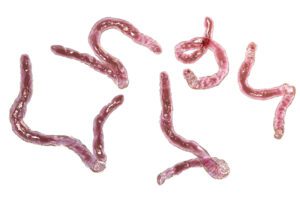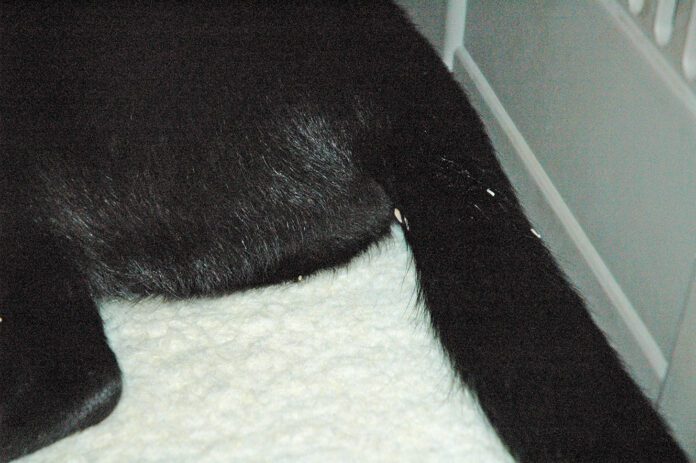Intestinal parasites – such as roundworms, whipworms, hookworms, and tapeworms – are common in dogs and puppies. Mango worms and cuterebra (pronounced cue-tuh-RE-bra) are fly larvae that infect the skin but are not common parasites.
Roundworms
Roundworms are thin, light tan-colored worms that are about one to two millimeters wide (about 1/16 of an inch) and anywhere from four to fifteen centimeters long (about 1 ½ to 6 inches). One end of the worm is shaped like a spear and the other end is lightly coiled. When alive, the entire roundworm will become tightly coiled like a snake.

Most adult dogs will not exhibit any symptoms when they are infected with roundworm. It’s rare, but some adult dogs may vomit live roundworms or may have roundworms in their poop.
Puppies infected with roundworm will often have a pot-bellied appearance and a dull haircoat. They may have diarrhea that contains mucus. Unlike adult dogs, infected puppies will often vomit live roundworms and have roundworms in their poop.
Whipworms
Whipworms are extremely thin, white worms that are about 4.5 to 7.5 centimeters long (about 2 to 3 inches). The worm resembles a leather whip (like the one used in the Indiana Jones movies). One end of the worm is thick like a whip’s handle and the other end is thin like a whip’s lash.
Dogs who have only a small number of whipworms in their small and large intestines do not typically show any symptoms of whipworm infection. Dogs who are infected with a large amount of whipworms will often exhibit weight loss and diarrhea.
Hookworms
Hookworms are off-white colored worms that are four to five millimeters wide (about ⅛ of an inch) and one to two centimeters long (about ½ to ¾ of an inch). These worms have a hook on one end that resembles a fish hook.

Dogs who have only a small number of hookworms in their small intestines do not typically show any symptoms of hookworm infection. Dogs who are infected with a large amount of hookworms may have dark, tarry stool. Left untreated, these dogs may become anemic, lethargic, and lose weight.
Puppies infected with hookworm will often have anemia that can become life-threatening. These puppies may also be thin and lethargic.
Hookworm can also cause pruritic pododermatitis. Hookworm is often thought of as being an intestinal parasite. But hookworm can also enter a dog’s body through penetration of the skin, typically the underside of the webbing between their toes. Hookworm causes an intense itching when it penetrates the skin.
Tapeworms
Tapeworms are off-white colored worms that are 15 to 70 centimeters long (about 6 inches to over two feet). The part of the tapeworm that most people see in a dog’s poop or on the skin around the anus is the proglottid – a segment of the mature worm that breaks off and is released into the dog’s poop. These proglottids, which resemble small grains of rice and may appear around the dog’s anus, or stuck to his fur near his anus, also contain tapeworm eggs.
Dogs rarely show any symptoms of tapeworm infection. The presence of tapeworm proglottids may cause irritation of the skin around the anus, resulting in a dog scooting his butt on the ground.
There are two parasites that can infect dogs through their skin, when dogs come into contact with their larvae in soil. The first-stage larvae burrow through the dog’s skin and develop into later-stage larvae, and, eventually into a botfly, which lays its eggs in soil.
Mango worms
The mango worm the larvae of the African tumbu fly. After getting through the dog’s skin, the larva creates a small furuncle that looks like a pimple. The furuncle has a small opening through which the larva breathes.
Once inside the skin, the larva molts into a second stage larva and then a third stage larva. The second stage larva is shaped like a club and is 2.5 to 4.0 millimeters long (about ⅛ of an inch). The third stage larva is shaped like a cylinder and is about 1.5 centimeters long (about ½ of an inch). The initial furuncle may be itchy for a couple of days and then subside. As the larva grows and matures, the furuncle may develop into a painful boil with a weeping discharge. Once the larva has reached maturity, it leaves the boil to finish pupating into the tumbu fly.
Mango worms are endemic in the sub-Saharan region of Africa. Infection with this larva is rarely seen in the United States. When infection with mango worms is seen in the United States, it is typically associated with recent travel to Africa. So, unless your dog is a world traveler, you don’t need to worry about mango worms!
Cuterebra
Cuterebra is the larva of the rabbit botfly. This larva also burrows into the skin and initially creates a small swelling about one centimeter wide. As the larva grows and matures, the swelling can become large and painful and look like an abscess. The swelling will have a small hole in the middle through which the larva breathes. If you look carefully at the hole, you may see the larva moving inside!
Unlike the mango worm, cuterebra is found throughout the United States. Immature larvae are grey or cream-colored, shaped like a cylinder with little ridges, and 0.5 to 1 centimeter long (about ¼ to ½ inch). The mature larvae are dark grey, can be up to three centimeters long (about 1 ¼ inches) and are cylindrically shaped with many ridges and spines.





